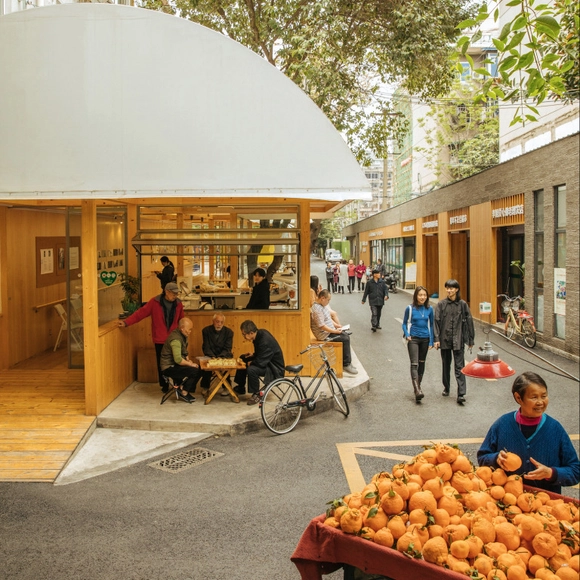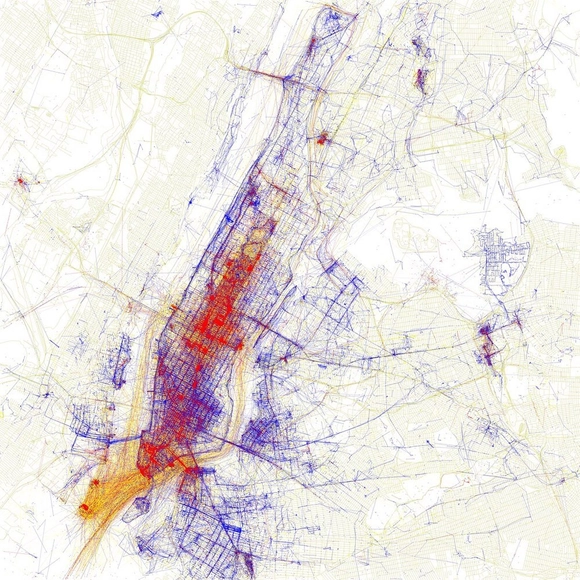A step-by-step outline on how to turn 3D models in SketchUp into 2D documentation through LayOut.
News
Generating Documentation With SketchUp
New Uses and Contemporary Guidelines for Public Spaces

Urban public spaces can transform the life of neighborhoods and cities and, therefore, need to be open to the social, cultural and technological changes that occur in society. From urban vegetable gardens to pet spaces, from rain gardens to art pavilions, life in today's cities has created new demands and ways of using and appropriating public spaces.
There’s More Than One Way to Define Context

This article was originally published on Common Edge.
It’s finally time to write this down. For years—in meetings, on-campus tours, and informal conversations—I have talked about the University of California Berkeley’s Wurster Hall, now Bauer Wurster Hall, encouraging people to see and appreciate the significance, and beauty, of this building. It hasn’t been an easy case to make.
Bauer Wurster Hall is the home of the school’s College of Environmental Design (CED). Originally, it housed the departments of architecture, landscape architecture, planning, and design. The building was purpose-designed and built for the CED, a new college founded in 1959 that brought these departments together for the first time. William Wurster, for whom the building was originally named, was the college’s founding dean and the building’s visionary client.
Housing in Copenhagen: A Commitment to Equality and Community Living

When we google 'housing in Copenhagen', the first thing that pops up are the most common questions asked by users: how much does it cost to live in Copenhagen? Is it difficult to find housing in Copenhagen? It's true, living here is significantly more expensive than the European average, especially in its most central district: Indre By. Although the housing prices are adapted to the salaries of its citizens –and the quality of life index is consistent with this high cost–, it's still complex for a foreigner to settle permanently in the city.
However, there is a serious commitment from the authorities and stakeholders to kindly open the city to new inhabitants, offering affordable housing designed by its best architects –both in suburbs and in refurbished downtown areas. In 2023, Copenhagen will be the UNESCO-UIA World Capital of Architecture and the host of the UIA World Congress of Architects, so a large number of people will be able to see firsthand what it's like to inhabit the city in projects of great architectural quality, which not only integrate wisely into its vibrant urban life, but also propose innovative ways of living.
A-lab and LPO Unveil Design for a Mixed-Use Development as Part of Fjord City Oslo, a Large-Scale Urban Renewal Project

Norwegian architecture offices A-lab and LPO revealed the plan to develop the last remaining plot in Bispevika, part of the Fjord City, a large-scale waterfront urban renewal project in the center of Oslo, Norway. The intervention strengthens the connection between the historic medieval city of Oslo to the new Fjord City while also introducing cultural, creative, and commercial activities to the area. The project comprises five buildings forming a quarter. The proposed massing and height take a contextual approach as they are reduced toward important local monuments such as the baroque residence “Ladegården” with its baroque garden “Barokkhagen." The project is developed by Oslo S Utvikling (OSU), the same client behind the Barcode project, and in collaboration with landscape architects SLA.
Colors That Bring Structure Into Focus

Besides changing our perception of interior spaces, colors are an excellent device for architects. With them, it is possible to highlight some elements or areas, create rhythm in the environment and give possible hints on how the eye can travel through it. One of the alternatives to achieve these goals is to paint the structures, which can bring a solid identity to the project since its components stand out and make the spatial notion even more playful.
Living Together: Collective Dwelling and Its Relationship With the Site

The demolition of the Pruitt-Igoe housing project will be 50 years old in 2022. Many ideas of how to live collectively have changed since then. Check out some housing projects in which the placement values encounters and community living.
The Pruitt-Igoe Housing Project, designed by Minoru Yamasaki, is considered a landmark of modernist architecture. Its high towers, inspired by Le Corbusier's Unité d'Habitation, which totaled almost 3000 units, set out to fill about half of the government-indicated housing deficit in the 1950s in St. Louis, USA. Besides the innovative architectural project, the government also bet on an interracial coexistence that involved poor and vulnerable strata of society - in the middle of the segregationist period in the United States.
MVRDV Wins Competition to Design the Master Plan for a Taiwanese Town’s Water Network

International office MVRDV has been selected by the Taiwan Ministry of Economic Affairs to design the Hoowave Water Factory, a large-scale redevelopment of Huwei’s Beigang and Anqingzhen waterways. The project combines a strategic master plan with the landscape design in an effort to move beyond the mono-functional approach for controlling and distributing water. Besides storing and capturing water, the proposal also opens up access to the river and the natural ecosystem by integrating cycling paths, cultural amenities, and ecological systems. The master plan also includes a comprehensive strategy for flood resilience while improving the quantity and quality of available water. The project is expected to be completed in 2026.
A New Milestone for Gaudí’s Sagrada Familia in Barcelona

Gaudí's Sagrada Familia in Barcelona has illuminated the terminals on the towers of the Evangelists Luke and Mark, celebrating the completion of these two new structures that reach 135 meters in height. Together with the tower of the Virgin Mary, inaugurated in December 2021, 3 of the 6 central towers will be completed.
Mobility, Managerial Competencies and the Future of Architectural Practice in The 2020's

As the world slowly adjusts to the "new normal," so too does the architecture industry. Data related to market size and workloads shows that the profession continued to grow even after the pandemic struck. Other statistics show how architects are starting to be hit by the present crisis – such as the fall in full-time work and rising unemployment. While these statistics could take one down a road of despair (or enthusiasm), there is more to the numbers: Mobility, digital and managerial competencies are framing the profession in the 2020's. Not only as data for the sector to approach the market and retain talent but also as strategies in the face of crises and technologies to come.
What Kind of City is a People-Oriented City? Ranking Chinese Cities

What kind of city is a people-oriented city? This is a difficult question to answer because humanistic cities evaluate the city by "people”, and people are extremely diverse, producing individual different evaluation standards. For example, a city that is friendly to car drivers, may not be so friendly to pedestrians.
Nonetheless, there is a general perception that some cities seem to be more friendly to people than others. Why is this the situation?
The 2022 Pivots in Architecture

Every “Year In Review” assessment of anything is both myopic and timely. That being said, 2022 was a "Boom" time for architects (and the building industry in general). This snapshot will change in 2023 when this year’s manufactured interest rate jumps will crib death this short and intense boom.
But some things have more meaning than can be found in the moment. 2022 proved that the “Mad Men” model in the profession as a white male clubhouse is over. Gender and race inequalities remain in architecture, but they are acknowledged flaws in urgent need of correction. Beyond these evolutions and revolutions, a new generation of architects is changing the profession.
The Decarbonization Challenge: 4 Passive Strategies for Energy-Efficient Building Systems

Nearly 40% of the energy produced in the U.S. is used for building operations. The near-central role of buildings in the global climate and energy scenario makes it crucial for architects, engineers and building owners to take appropriate action. These stakeholders can help reduce the carbon footprint of the building through strategic design decisions.
Conventionally, the active modes of heating, cooling, ventilation and lighting utilize energy-intensive electrical processes. On the other hand, passive measures help maintain indoor thermal comfort using the inherent physical and thermal properties of the building envelope and its surroundings
Typically, a well-designed and well-operated building uses envelope-level passive measures to minimize the thermal loads first. Then, it uses energy-efficient active modes of heating, cooling, ventilation and lighting. This article highlights 4 key envelope-level passive strategies to implement for decarbonizing building systems.
KPF Reveals Design for a Mixed-Use Neighborhood in Seoul, South Korea

International architecture office KPF has unveiled the design for Parkside Seoul, a new mixed-use neighborhood planned for the South Korean capital designed to complement the surrounding natural elements and pay homage to Yongsan Park. The 482,600 square meter development is composed of a layered exterior envelope that encompasses various programs and public amenities with the purpose of enhancing the residents’ experience of space. Besides the residential units, the complex includes office and retail spaces, and hospitality facilities along with public and green spaces.
A City's Trash is Not It's Treasure: How is New York Tackling its Garbage Issues?

The scene is almost identical, no matter which borough of New York City you’re in. Narrow sidewalks are lined by mountains of trash bags and other large objects, waiting for their turn to be taken away by the fleet of sanitary workers and trucks who will dispose of them. Large rodents seek shelter in their temporary plastic homes, feeding on discarded scraps, becoming a regular sighting for New York City residents. The City That Never Sleeps has a bigger problem than the flashing lights and noisy streets- it’s all of the trash that’s left to sit out on the sidewalks.
Argentina at the Venice Architecture Biennale 2023: Diego Arraigada’s ‘The Future of Water'

On December 13th, the Directorate of Cultural Affairs of the Argentinian Foreign Ministry announced the winners of its open curatorial competition to select the country's entry for the 18th International Architecture Exhibition of the Venice Biennale, which will take place next year from May 20th to November 26th.
A Brief History of Maps and Their Role in Urban Development

Cartography, or map making, has played a critical role in representing spatial concepts for thousands of years. While the earliest forms of maps displayed geographic information carved into clay tablets and etched onto cave walls, the maps we use today have significantly evolved to creatively show a range of different information. These visualizations draw conclusions about population sizes, historical events, cultural shifts, and weather patterns to help us understand more about our world and how we impact it.
Lesley Lokko, the Curator of the 2023 Venice Architecture Biennale, Recognized in King Charles' First New Year Honours List

On Friday, King Charles III has released the New Year Honours List 2023, recognizing those in the UK who have demonstrated exemplary service or achievements in their fields. Ghanian-Scottish architect, academic, and novelist Lesley Lokko is among those who have been named an Office of the Order of the British Empire (OBE) for her services to architecture and education. In December 2021, Lesley Lokko was announced as the Curator of the 18th International Architecture Exhibition - La Biennale di Venezia, which will be held from Saturday, 20 May to Sunday, 26 November 2023.
Venice Authorities Install Glass Barriers at St Mark’s Basilica to Prevent Flooding

The Italian city installed glass barriers around the 900-year-old church to keep the waters out. The decision was made after near-record flooding in December 2022, preventing a repeat of the November 2019 near-catastrophe that aged parts of the building “20 years in a day,” according to Basilica’s Procuratoria governing body. The temporary structure is fixed until the MOSE system fully works by the end of 2025, protecting the city of Venice, Italy, and the Venetian Lagoon from flooding.
What is Universal Design?

Created by the American architect Ron Mace in the 1980s, the concept of Universal Design deals with the perception of the projects and environments that we design and inhabit, considering the possibility of its use by different user profiles: from children to the elderly, including language limitations and people with disability or temporary limitations.
The Definitive Works of 2019 Pritzker Prize Winner Arata Isozaki

Japanese architect and theorist Arata Isozaki, winner of 2019's Pritzker Prize, passed away at the age of 91. Since the 60s, Isozaki has been showing outstanding innovative ideas in his works, influencing eastern professionals with a forward-thinking approach that takes its roots from Japan. In a special tribute to the architect's achievements, ArchDaily highlights the immense list of Arata Isozaki’s projects and recreates the architect's professional development path since his very first works.



























































































